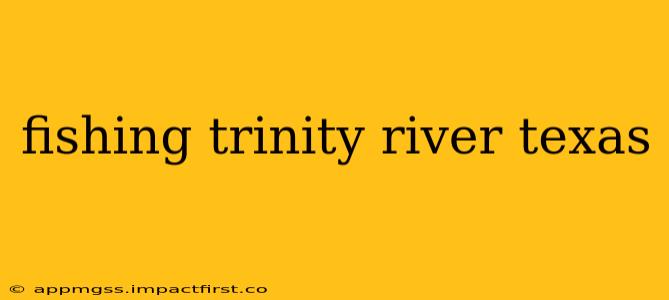The Trinity River, a sprawling waterway coursing through Texas, offers a diverse and rewarding fishing experience for anglers of all skill levels. From its headwaters in Northeast Texas to its mouth at Galveston Bay, this river system boasts a surprising variety of fish species and habitats. This guide will explore the best fishing spots, target species, techniques, and regulations to ensure a successful and enjoyable fishing trip on the Trinity River.
What Types of Fish are in the Trinity River?
The Trinity River's diverse ecosystem supports a wide range of fish species. Popular targets include:
- Largemouth Bass: A staple in Texas waters, largemouth bass are abundant throughout the Trinity River. Their size varies depending on location and habitat.
- Channel Catfish: These whiskered bottom-feeders are another highly sought-after species, known for their impressive size and fighting ability.
- White Crappie: These panfish are a delightful catch, perfect for a delicious meal. They thrive in the river's calmer, vegetated areas.
- Blue Catfish: While less common than channel catfish, the Trinity River does hold populations of blue catfish, which can reach truly impressive sizes.
- Gar: These ancient fish are a unique challenge for anglers and offer a thrilling fight. There are several types of gar found in the Trinity.
- Sunfish (various species): Numerous species of sunfish provide excellent sport for families and beginners.
Where is the Best Fishing on the Trinity River?
The best fishing spots along the Trinity River vary depending on the target species and time of year. Some popular areas include:
- Lake Livingston: Located upstream, this reservoir offers excellent largemouth bass and crappie fishing.
- Lake Fork: While technically a separate lake, its connection to the Trinity River system makes it a significant fishing destination known for trophy-sized largemouth bass.
- Areas near Dallas and Fort Worth: Although urbanized, sections of the Trinity River within and near these major cities still offer surprisingly good fishing opportunities, particularly for catfish.
- Downstream sections toward Galveston Bay: This area is known for its saltwater influence, providing opportunities to catch saltwater species as well as brackish water fish.
Remember to consult updated fishing maps and reports for the most current information on fish activity and access points.
What is the Best Time of Year to Fish the Trinity River?
The best time to fish the Trinity River depends largely on your target species and preferred fishing conditions. Generally:
- Spring and Fall: These shoulder seasons often provide the most consistent and comfortable fishing conditions, with moderate temperatures and increased fish activity.
- Summer: While hot, summer can be a productive time for nighttime fishing, especially for catfish.
- Winter: Fishing can be slower during winter, though some species remain active.
What is the Best Bait or Lures for Fishing the Trinity River?
The best bait or lure will depend on your target species and the fishing conditions. Popular choices include:
- Largemouth Bass: Spinnerbaits, crankbaits, plastic worms, and topwater lures are effective.
- Channel Catfish: Live bait such as worms, minnows, and shad are popular choices. Chicken liver is another effective option.
- White Crappie: Small jigs, minnows, and small crankbaits work well.
- Blue Catfish: Larger live bait, cut bait, or stink bait are frequently used.
What are the Fishing Regulations for the Trinity River?
Before heading out, it's crucial to familiarize yourself with Texas Parks and Wildlife Department (TPWD) fishing regulations. These regulations cover licensing requirements, size and bag limits, and protected species. Always check the TPWD website for the most up-to-date information. This includes understanding any specific regulations for the section of the Trinity River you plan to fish.
What are Some Tips for Successful Fishing on the Trinity River?
- Research your target species: Understand their habits, preferred habitats, and feeding patterns.
- Check weather conditions: Wind, rain, and temperature can significantly impact fishing success.
- Use appropriate tackle: Choose rods, reels, and lines suited to your target species and fishing style.
- Be patient: Fishing requires patience and persistence.
- Practice catch and release: Help ensure the sustainability of the Trinity River's fish populations.
- Respect the environment: Leave no trace and adhere to all park rules and regulations.
This guide provides a solid foundation for planning your fishing trip on the Trinity River. Remember that successful fishing often involves combining knowledge, skill, and a bit of luck. Happy fishing!
